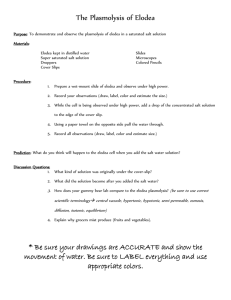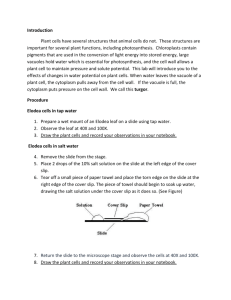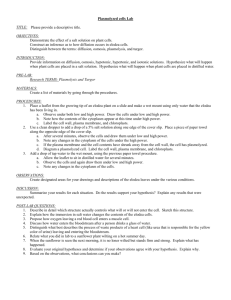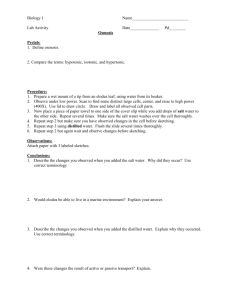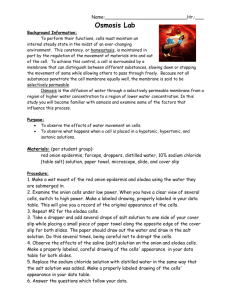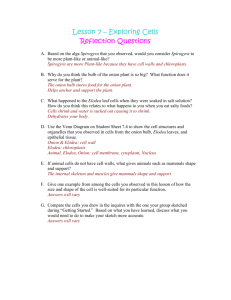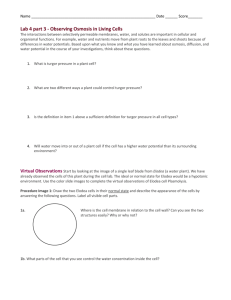Name: Period: Date: Lab: Osmosis in Plant Cells Introduction: In
advertisement
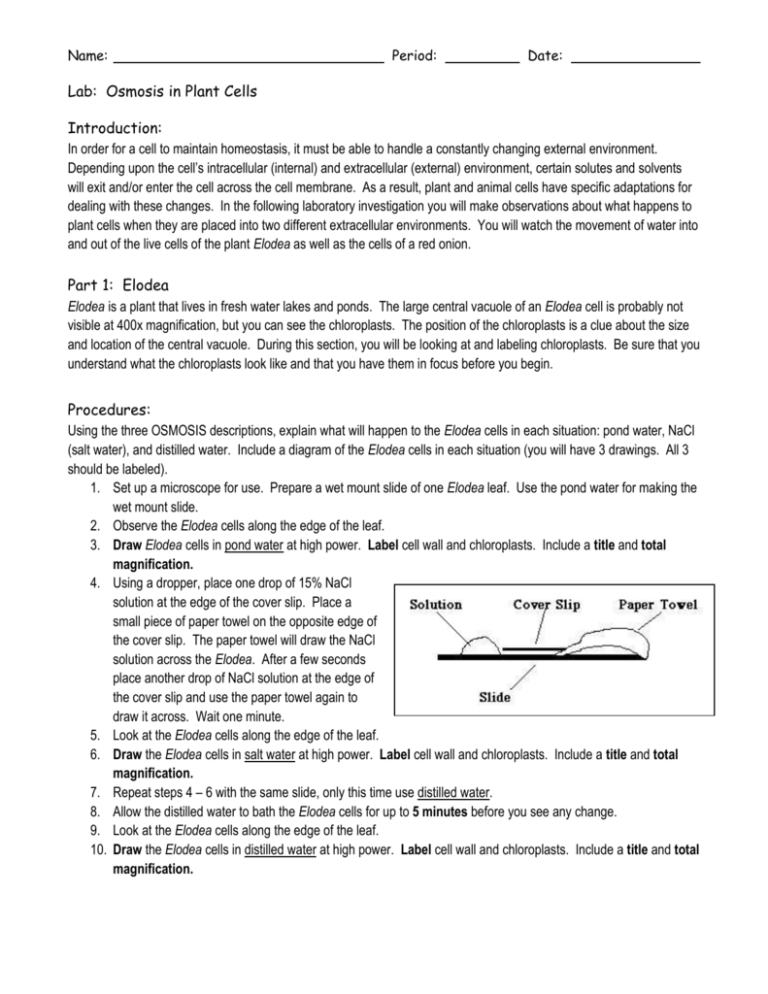
Name: Period: Date: Lab: Osmosis in Plant Cells Introduction: In order for a cell to maintain homeostasis, it must be able to handle a constantly changing external environment. Depending upon the cell’s intracellular (internal) and extracellular (external) environment, certain solutes and solvents will exit and/or enter the cell across the cell membrane. As a result, plant and animal cells have specific adaptations for dealing with these changes. In the following laboratory investigation you will make observations about what happens to plant cells when they are placed into two different extracellular environments. You will watch the movement of water into and out of the live cells of the plant Elodea as well as the cells of a red onion. Part 1: Elodea Elodea is a plant that lives in fresh water lakes and ponds. The large central vacuole of an Elodea cell is probably not visible at 400x magnification, but you can see the chloroplasts. The position of the chloroplasts is a clue about the size and location of the central vacuole. During this section, you will be looking at and labeling chloroplasts. Be sure that you understand what the chloroplasts look like and that you have them in focus before you begin. Procedures: Using the three OSMOSIS descriptions, explain what will happen to the Elodea cells in each situation: pond water, NaCl (salt water), and distilled water. Include a diagram of the Elodea cells in each situation (you will have 3 drawings. All 3 should be labeled). 1. Set up a microscope for use. Prepare a wet mount slide of one Elodea leaf. Use the pond water for making the wet mount slide. 2. Observe the Elodea cells along the edge of the leaf. 3. Draw Elodea cells in pond water at high power. Label cell wall and chloroplasts. Include a title and total magnification. 4. Using a dropper, place one drop of 15% NaCl solution at the edge of the cover slip. Place a small piece of paper towel on the opposite edge of the cover slip. The paper towel will draw the NaCl solution across the Elodea. After a few seconds place another drop of NaCl solution at the edge of the cover slip and use the paper towel again to draw it across. Wait one minute. 5. Look at the Elodea cells along the edge of the leaf. 6. Draw the Elodea cells in salt water at high power. Label cell wall and chloroplasts. Include a title and total magnification. 7. Repeat steps 4 – 6 with the same slide, only this time use distilled water. 8. Allow the distilled water to bath the Elodea cells for up to 5 minutes before you see any change. 9. Look at the Elodea cells along the edge of the leaf. 10. Draw the Elodea cells in distilled water at high power. Label cell wall and chloroplasts. Include a title and total magnification. Part 2: Red Onion Cell During this section you will observe the effects of isotonic, hypotonic, and hypertonic environments on red onion plant cells. You will be making two drawings at high power – onion cell in distilled water and onion cell in salt water (NaCl). Procedure: 1. Make a wet mount slide with distilled water using the thin outer membrane of a red onion. 2. Make observations of SEVERAL CELLS. Make sure that your cells are in focus. 3. Draw the cells under high power. 4. Label cell wall, cell membrane, nucleus, and large central vacuole. Include a title and total magnification. 5. Using a dropper, place several drops of 15% NaCl solution (salt water) at one edge of the cover slip. 6. While observing the red onion cells through the microscope, place a piece of paper towel at the OPPOSITE SIDE of the cover slip. This will draw the salt solution under the cover slip. You may need to repeat this step to ensure that the salt water has completely replaced the distilled water. 7. Wait two minutes and make observations about what happens to the red onion cells AFTER being exposed to the salt water. 8. Draw the cells under high power. 9. Label cell wall, cell membrane, nucleus, and large central vacuole. For each drawing include a title and total magnification. Return the microscope to its correct location Carefully clean the microscope slides and cover slips Place everything back in its original location so that it is ready for the next class. Summary Questions – answer using complete sentences 1. What are the functions of the Elodea cell organelles (cell wall and chloroplasts)? 2. Describe what occurred when the Elodea was exposed to the salt water solution. 3. Would you see the same effect in Elodea cells if you used a glucose solution instead of a salt water solution? Explain. 4. Define and explain hypertonic, hypotonic, and isotonic. 5. What happens to the red onion cell when it is exposed to salt water? Explain why this happened and how it changed from when it was in the distilled water solution. 6. When the red onion cell was in the salt water, was the cell’s outer environment hypertonic or hypotonic? Explain. 7. If we did this lab with ANIMAL cells instead of plant cells, what observable differences might you have seen when the cell was placed in the salt water (think of the organelles)? Explain. 8. Define turgor pressure. Identify and describe which solution in this lab created a turgor pressure effect. 9. Define plasmolysis. Identify and describe which solution in this lab created a plasmolysis effect. Summary Questions – answer using complete sentences 1. What are the functions of the Elodea cell organelles (cell wall and chloroplasts)? 2. Describe what occurred when the Elodea was exposed to the salt water solution. 3. Would you see the same effect in Elodea cells if you used a glucose solution instead of a salt water solution? Explain. 4. Define and explain hypertonic, hypotonic, and isotonic. 5. What happens to the red onion cell when it is exposed to salt water? Explain why this happened and how it changed from when it was in the distilled water solution. 6. When the red onion cell was in the salt water, was the cell’s outer environment hypertonic or hypotonic? Explain. 7. If we did this lab with ANIMAL cells instead of plant cells, what observable differences might you have seen when the cell was placed in the salt water (think of the organelles)? Explain. 8. Define turgor pressure. Identify and describe which solution in this lab created a turgor pressure effect. 9. Define plasmolysis. Identify and describe which solution in this lab created a plasmolysis effect. Summary Questions – answer using complete sentences 1. What are the functions of the Elodea cell organelles (cell wall and chloroplasts)? 2. Describe what occurred when the Elodea was exposed to the salt water solution. 3. Would you see the same effect in Elodea cells if you used a glucose solution instead of a salt water solution? Explain. 4. Define and explain hypertonic, hypotonic, and isotonic. 5. What happens to the red onion cell when it is exposed to salt water? Explain why this happened and how it changed from when it was in the distilled water solution. 6. When the red onion cell was in the salt water, was the cell’s outer environment hypertonic or hypotonic? Explain. 7. If we did this lab with ANIMAL cells instead of plant cells, what observable differences might you have seen when the cell was placed in the salt water (think of the organelles)? Explain. 8. Define turgor pressure. Identify and describe which solution in this lab created a turgor pressure effect. 9. Define plasmolysis. Identify and describe which solution in this lab created a plasmolysis effect. Summary Questions – answer using complete sentences 1. What are the functions of the Elodea cell organelles (cell wall and chloroplasts)? 2. Describe what occurred when the Elodea was exposed to the salt water solution. 3. Would you see the same effect in Elodea cells if you used a glucose solution instead of a salt water solution? Explain. 4. Define and explain hypertonic, hypotonic, and isotonic. 5. What happens to the red onion cell when it is exposed to salt water? Explain why this happened and how it changed from when it was in the distilled water solution. 6. When the red onion cell was in the salt water, was the cell’s outer environment hypertonic or hypotonic? Explain. 7. If we did this lab with ANIMAL cells instead of plant cells, what observable differences might you have seen when the cell was placed in the salt water (think of the organelles)? Explain. 8. Define turgor pressure. Identify and describe which solution in this lab created a turgor pressure effect. 9. Define plasmolysis. Identify and describe which solution in this lab created a plasmolysis effect.
